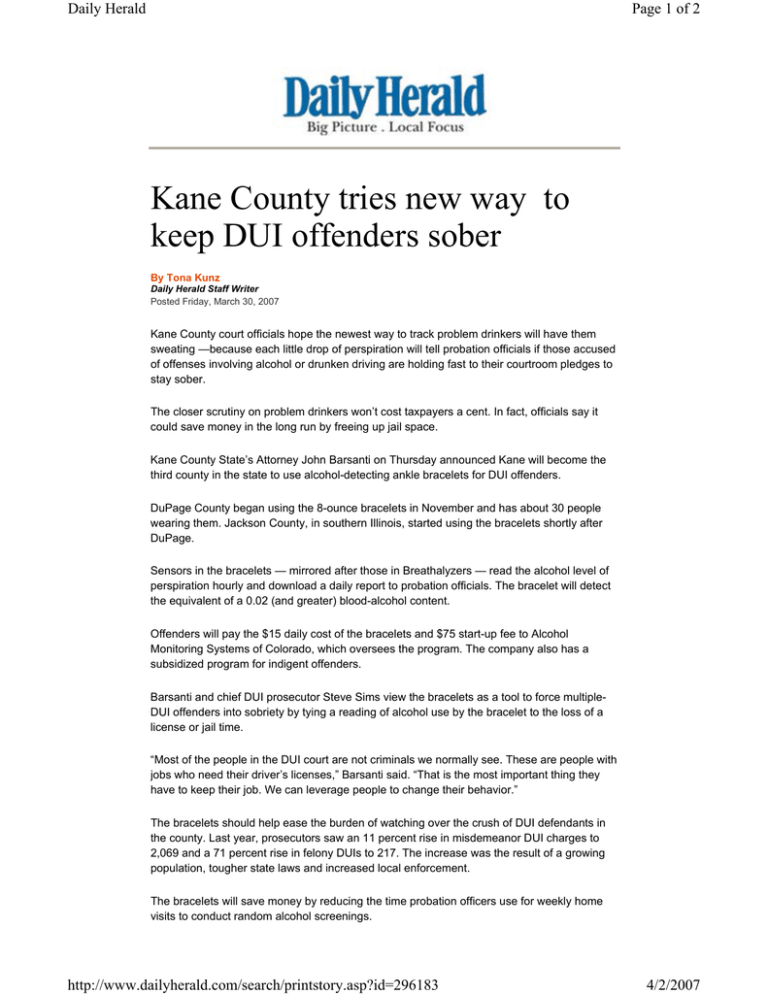Kane County tries new way to keep DUI offenders sober
advertisement

Daily Herald Page 1 of 2 Kane County tries new way to keep DUI offenders sober By Tona Kunz Daily Herald Staff Writer Posted Friday, March 30, 2007 Kane County court officials hope the newest way to track problem drinkers will have them sweating —because each little drop of perspiration will tell probation officials if those accused of offenses involving alcohol or drunken driving are holding fast to their courtroom pledges to stay sober. The closer scrutiny on problem drinkers won’t cost taxpayers a cent. In fact, officials say it could save money in the long run by freeing up jail space. Kane County State’s Attorney John Barsanti on Thursday announced Kane will become the third county in the state to use alcohol-detecting ankle bracelets for DUI offenders. DuPage County began using the 8-ounce bracelets in November and has about 30 people wearing them. Jackson County, in southern Illinois, started using the bracelets shortly after DuPage. Sensors in the bracelets — mirrored after those in Breathalyzers — read the alcohol level of perspiration hourly and download a daily report to probation officials. The bracelet will detect the equivalent of a 0.02 (and greater) blood-alcohol content. Offenders will pay the $15 daily cost of the bracelets and $75 start-up fee to Alcohol Monitoring Systems of Colorado, which oversees the program. The company also has a subsidized program for indigent offenders. Barsanti and chief DUI prosecutor Steve Sims view the bracelets as a tool to force multipleDUI offenders into sobriety by tying a reading of alcohol use by the bracelet to the loss of a license or jail time. “Most of the people in the DUI court are not criminals we normally see. These are people with jobs who need their driver’s licenses,” Barsanti said. “That is the most important thing they have to keep their job. We can leverage people to change their behavior.” The bracelets should help ease the burden of watching over the crush of DUI defendants in the county. Last year, prosecutors saw an 11 percent rise in misdemeanor DUI charges to 2,069 and a 71 percent rise in felony DUIs to 217. The increase was the result of a growing population, tougher state laws and increased local enforcement. The bracelets will save money by reducing the time probation officers use for weekly home visits to conduct random alcohol screenings. http://www.dailyherald.com/search/printstory.asp?id=296183 4/2/2007 Daily Herald Page 2 of 2 About 30,000 people in 32 states are wearing the bracelets. The technology, called SCRAM for Secure Continuous Remote Alcohol Monitoring, has passed two commonly used legal thresholds for reliability. The system has yet to face scrutiny in any state appeals courts since it was launched in Michigan in 2003 but has survived lower court challenges in nine states, said Robert Murnock, Midwest regional manager for Alcohol Monitoring Systems. Initially, Kane will use the bracelets as part of plea bargain sentences and as a way to allow low-income defendants to volunteer for the bracelets while awaiting trial in exchange for lower bonds, freeing up jail space. Barsanti said the bracelets could be expanded to community intervention programs and domestic violence courtrooms in the future. Officials also are considering adding bracelets to DUI sentences stemming from trials. In Illinois, however, civil rights groups and defense attorneys have criticized any move to make the bracelets mandatory, citing the Big Brother factor. tkunz@dailyherald.com dailyherald.com http://www.dailyherald.com/search/printstory.asp?id=296183 4/2/2007







